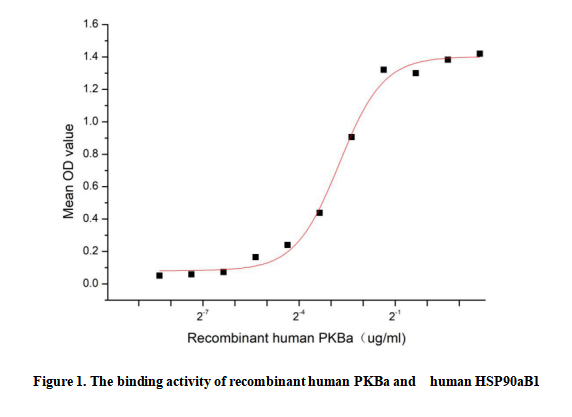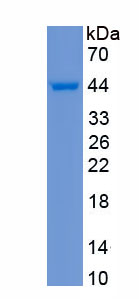Active Protein Kinase B Alpha (PKBa) 

AKT1; AKT; PKB-A; Proto-oncogene c-Akt; RAC-Alpha Serine/Threonine-Protein Kinase; V-akt Murine Thymoma Viral Oncogene Homolog 1
- UOM
- FOB US$ 247.00 US$ 618.00 US$ 1,236.00 US$ 3,708.00 US$ 9,270.00
- Quantity
Overview
Properties
- Product No.APC231Hu01
- Organism SpeciesHomo sapiens (Human) Same name, Different species.
- ApplicationsCell culture; Activity Assays.
Research use only - DownloadInstruction Manual
- CategoryEnzyme & Kinase
- Buffer FormulationPBS, pH7.4, containing 0.01% SKL, 5% Trehalose.
- Traits Freeze-dried powder, Purity > 95%
- Isoelectric Point6.5
Sign into your account
Share a new citation as an author
Upload your experimental result
Review

Contact us
Please fill in the blank.
Activity test

Protein Kinase B Alpha (PKBa), also known as AKT1, is a key member of the AKT family of serine/threonine kinases, which play a crucial role in various cellular processes including cell growth, proliferation, differentiation, and survival. PKBa is activated by insulin and growth factor signaling and phosphorylates a variety of substrates to regulate these cellular functions.The activation of akt1 requires the association with Heat Shock Protein 90kDa Alpha B1 (HSP90aB1), resulting in an active auto-regulatory cycle.Thus a functional ELISA assay was conducted to detect the interaction of recombinant human PKBa and recombinant human HSP90aB1. Briefly, PKBa was diluted serially in PBS with 0.01% BSA (pH 7.4). Duplicate samples of 100 μl were then transferred to HSP90aB1-coated microtiter wells and incubated for 1h at 37℃. Wells were washed with PBST and incubated for 1h with anti-PKBa pAb, then aspirated and washed 3 times. After incubation with HRP labelled secondary antibody for 1h at 37℃, wells were aspirated and washed 5 times. With the addition of substrate solution, wells were incubated 15-25 minutes at 37℃. Finally, add 50 µL stop solution to the wells and read at 450/630nm immediately. The binding activity of recombinant human PKBa and recombinant human HSP90aB1 was shown in Figure 1, the EC50 for this effect is 0.149ug/mL.
Usage
Reconstitute in 10mM PBS (pH7.4) to a concentration of 0.1-1.0 mg/mL. Do not vortex.
Storage
Avoid repeated freeze/thaw cycles. Store at 2-8°C for one month. Aliquot and store at -80°C for 12 months.
Stability
The thermal stability is described by the loss rate. The loss rate was determined by accelerated thermal degradation test, that is, incubate the protein at 37°C for 48h, and no obvious degradation and precipitation were observed. The loss rate is less than 5% within the expiration date under appropriate storage condition.
Increment services
-
 BCA Protein Quantification Kit
BCA Protein Quantification Kit
-
 Molecular Mass Marker for Protein
Molecular Mass Marker for Protein
-
 Monoclonal Antibody Customized Service
Monoclonal Antibody Customized Service
-
 Polyclonal Antibody Customized Service
Polyclonal Antibody Customized Service
-
 Protein Activity Test Experiment Service
Protein Activity Test Experiment Service
-
 Electrophoretic Mobility Shift Assay (EMSA) Experiment Service
Electrophoretic Mobility Shift Assay (EMSA) Experiment Service
-
 Buffer
Buffer
-
 Lentivirus Packaging Experiment Service
Lentivirus Packaging Experiment Service
-
 Adenovirus Packaging Experiment Service
Adenovirus Packaging Experiment Service
-
 Real Time PCR Experimental Service
Real Time PCR Experimental Service
-
 Spike RBD Protein (S-RBD)
Spike RBD Protein (S-RBD)
-
 Protein G
Protein G
-
 Protein A
Protein A
Citations
- Profiling of selected angiogenesis-related genes in proliferative eutopic endometrium of women with endometriosisPubmed: 24188612
- Beta-arrestin 1 is involved in the catabolic response stimulated by hyaluronan degradation in mouse chondrocytesPubmed:25673209
- Encapsulated VEGF 121-PLA microparticles promote angiogenesis in human endometrium stromal cells33523322
- In Vivo and In Vitro Enhanced Tumoricidal Effects of Metformin, Active Vitamin D3, and 5-Fluorouracil Triple Therapy against Colon Cancer by Modulating the …Pubmed:35326689
- Metformin and Calcitriol Enhance 5-Fluorouracil Tumoricidal Effects in Colon Cancer By Modulating The PI3K/Akt/PTEN/mTOR Network







